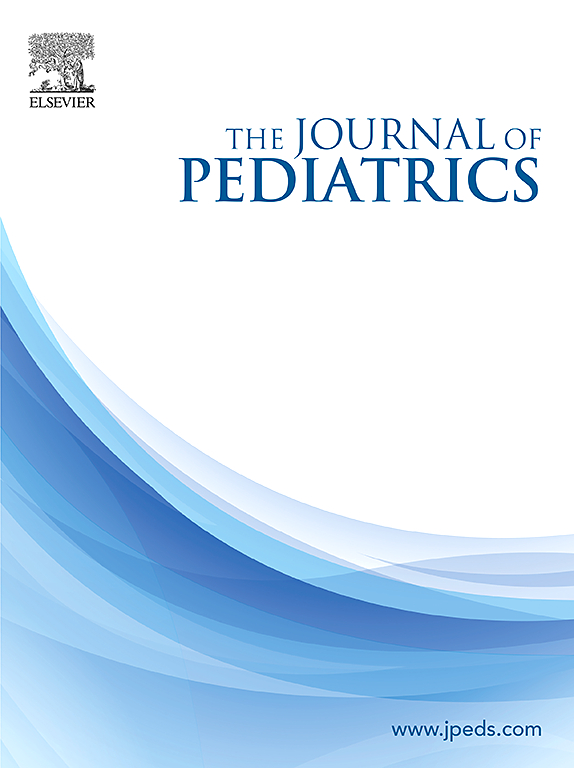Actionable Areas of Distress Among Pediatric Cardiology Fellows
IF 3.9
2区 医学
Q1 PEDIATRICS
引用次数: 0
Abstract
Objective
To quantify burnout and identify specific stressors among a national sample of pediatric cardiology fellows.
Study design
We invited program directors at all 61 Accreditation Council for Graduate Medical Education-accredited pediatric cardiology training programs to distribute a 40-item survey to their categorical (year 1-3) fellows from February to April 2023. The survey included the Stanford Professional Fulfillment Index and ratings of key stressors to understand levels of burnout and associated stressors.
Results
In total, 67% (261/391) of contacted pediatric cardiology fellows completed the survey, representing 50% of all categorical fellows in the US. Of these, 42% reported symptoms of burnout. Fellows without children were found to have increased odds of experiencing burnout symptoms compared with those with children (OR 2.03). 13 of 15 stressors were associated with increased burnout scores, of which “excessive number of work hours,” “challenges to prioritizing self-care,” and “mistreatment from supervisors” were the top 3.
Conclusion
This national study of pediatric cardiology fellows shows a high prevalence of burnout. The modifiable stressors identified in this study offer opportunities to improve the well-being of this group of trainees.
儿科心脏病学研究员的痛苦可采取行动的领域。
目的:在全国儿科心脏病学研究员样本中量化倦怠和识别特定的压力源。研究设计:我们邀请了所有61个acgme认可的儿科心脏病学培训项目的项目主任,在2023年2月至4月期间向他们的分类(1-3年级)研究员分发了一份40项的调查。这项调查包括斯坦福职业成就感指数和主要压力源的评级,以了解倦怠和相关压力源的水平。结果:总共有67%(261/391)的接触儿科心脏病学研究员完成了调查,占美国所有分类研究员的50%。其中,42%的人报告有倦怠症状。与有孩子的人相比,没有孩子的人出现倦怠症状的几率更高(OR 2.03)。在15个压力源中,有13个与倦怠得分增加有关,其中“工作时间过多”、“无法优先考虑自我照顾”和“主管虐待”是前三名。结论:这项针对儿科心脏病学研究人员的全国性研究显示,倦怠的患病率很高。本研究确定的可改变的压力源提供了改善这组受训者幸福感的机会。
本文章由计算机程序翻译,如有差异,请以英文原文为准。
求助全文
约1分钟内获得全文
求助全文
来源期刊

Journal of Pediatrics
医学-小儿科
CiteScore
6.00
自引率
2.00%
发文量
696
审稿时长
31 days
期刊介绍:
The Journal of Pediatrics is an international peer-reviewed journal that advances pediatric research and serves as a practical guide for pediatricians who manage health and diagnose and treat disorders in infants, children, and adolescents. The Journal publishes original work based on standards of excellence and expert review. The Journal seeks to publish high quality original articles that are immediately applicable to practice (basic science, translational research, evidence-based medicine), brief clinical and laboratory case reports, medical progress, expert commentary, grand rounds, insightful editorials, “classic” physical examinations, and novel insights into clinical and academic pediatric medicine related to every aspect of child health. Published monthly since 1932, The Journal of Pediatrics continues to promote the latest developments in pediatric medicine, child health, policy, and advocacy.
Topics covered in The Journal of Pediatrics include, but are not limited to:
General Pediatrics
Pediatric Subspecialties
Adolescent Medicine
Allergy and Immunology
Cardiology
Critical Care Medicine
Developmental-Behavioral Medicine
Endocrinology
Gastroenterology
Hematology-Oncology
Infectious Diseases
Neonatal-Perinatal Medicine
Nephrology
Neurology
Emergency Medicine
Pulmonology
Rheumatology
Genetics
Ethics
Health Service Research
Pediatric Hospitalist Medicine.
 求助内容:
求助内容: 应助结果提醒方式:
应助结果提醒方式:


